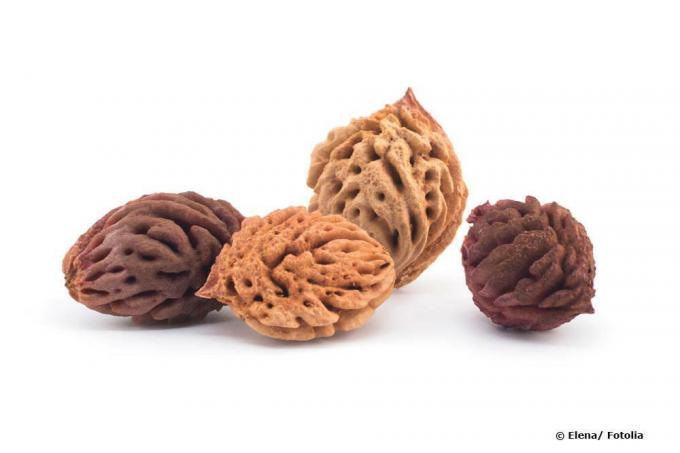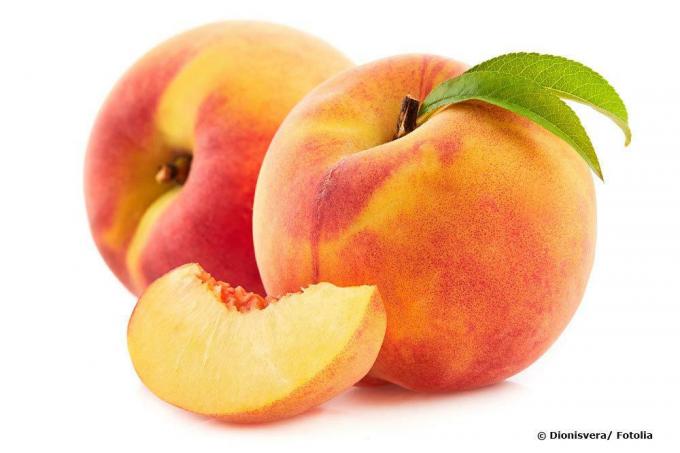
table of contents
- Overview of peach kernels and peach trees
- Varieties and seeds
- Genuine varieties
- ripe fruits
- Pulling a peach tree: instructions
- Preparation of the peach stone
- Cold spell
- Seedlings during the cold phase?
- Planting
- Planting out
- Selection and location
The peach tree or Prunus persica is characterized by its tasty fruits. The peach kernels contained in it are stone kernels and have exactly one seed. Pulling a peach from a pit takes patience and several steps. These range from the selection of suitable seeds to the choice of substrate to pre-cultivation and choice of location.
Overview of peach kernels and peach trees
The fruits of the peach contain a firmly anchored stone core that contains the seed. Basically, a peach tree pulled from the core needs a few years of care before it bears fruit itself. Some seeds and varieties do well for propagation, while others do not germinate. The growth and yield of the self-grown peach tree depend, among other things, on the selected variety.

Varieties and seeds
The right choice
Basically, the kernels of almost all known peach varieties have the potential to develop into trees. However, many of them do not develop as desired, remain small or do not produce any fruit.
In order to enjoy the peach tree project in the long term, we recommend absolutely real Sorts. These are also known as wild peaches. Core authenticity means that the attributes of the mother plant are transferred to the seed. Modern hybrids often lack the authenticity of the kernel, so that the seeds and the plants grown from them have different properties than the original plant. In the case of genuine varieties, gardeners can be certain that they can be used to grow a fruit-bearing peach tree.
Genuine varieties
Some of the genuine varieties already have their properties in their names. In general, many white-fleshed varieties belong to the real ones:
- Naundorf core genuine
- Foothill peach or Roter Ellerstädter
- White Ellerstadt
- Ussurian wild peach
- Proskauer
These varieties usually ripen from the end of August to mid-September. The Ussurian wild peach is a later variety.
ripe fruits
The right choice
In addition to the pure variety, the ripeness of the fruit in the peach tree also plays an important role. This is linked to the harvest time. Seedlings cannot usually be grown from insufficiently ripe peach stones. The ripeness of a peach can usually be recognized by the fact that the peach tree is already on its own Drops fruit. Care should be taken with purchased fruits, as they were often harvested in an unripe state. It is therefore advisable to buy peaches at the regular harvest time. Local varieties offer a greater chance of a ripe harvest. They also have the advantage of being adapted to the local environmental conditions.
In any case, it is worth planting several peach stones at the same time. This increases the likelihood that one of the seeds will develop well and the plant will grow well.
Pulling a peach tree: instructions
Preparation of the peach stone
First of all, the pulp around the peach core has to be removed. Special care is required here, because in the event of a longer storage, these pulp residues would otherwise rot. A brush and running water are recommended for cleaning. Then it is a good idea to put the peach stone on a newspaper or kitchen paper to dry for a few days.

Remove the peel from the seed?
The components of the peach stone include a woody shell and the inside Seeds. The question here is whether the hard wooden shell should be removed. The shell does not necessarily have to be removed because the seed will germinate even if it remains in the shell. Attempting to open the hard shell can also damage the seed.
If you still want to remove the peel, you should especially use the peach core let dry for a long time. This causes the seed to shrink a little and then come off the shell more easily. In addition, the wood becomes brittle and can then be opened with a nutcracker. Care should be taken when handling this seed. On the one hand it is very sensitive and on the other hand it contains poisonous cyanidee.
Cold spell
Significance of the cold spell
The peach stone needs a certain cold period before it can germinate. Botanists also speak of one Germ inhibitionthat prevents the seed from germinating at an unfavorable time of year. Young plants would not survive the impending frost. The peach core needs temperatures below 8 ° C to germinate. The process is used to break the inhibition of germs and is also called stratification.
In regions with long and cold winters, the peach kernel can be planted directly into the ground in autumn or winter. A shady location without direct sunlight is preferable. A sandy, water-permeable soil is suitable for growing a new peach tree. With a planting depth of 2 to 4 centimeters, the peach core only needs to be watered occasionally. The soil should be slightly damp, but not completely wet. This variant requires a permanent cold phase.
Artificial cold spell
The method of an artificial cold phase is safer. The core should be planted in a closable vessel with moist sand, which is then placed in the refrigerator. One challenge is to keep the core moist without the formation of mold. Before the peach stone goes into the jar, it should be soaked in water overnight. The right time is between mid-December and early January. By the beginning of spring, the kernel should rest in the refrigerator for about 8 weeks, keeping it moist. Alternatively, it can also be stored in a cool cellar, as long as the temperatures there do not exceed 7 ° C.
Seedlings during the cold phase?
Germination can already occur during stratification. In this case, the seedling should be planted immediately. These plants are very sensitive and therefore require careful handling. The core is to be placed on a humus soil mixture, whereby the direction of the planting must be taken into account. As a rule, the root grows first before the shoot shows up on the other side.
You should treat plants that have already germinated during the cold spell very carefully. Place the core on the humus soil mixture that you have filled up to 4 centimeters below the edge. Pay attention to the direction of planting. Of course, the root has to be planted at the bottom and the shoot at the top. If only a small green tip protrudes from the woody bowl, position it downwards. Because normally the root grows first and the actual shoot on the other side only significantly later.
Dealing with the seedlings
As soon as the seedlings have developed into a small peach tree, planting in a small pot is recommended. Vessels about 15 centimeters in size are suitable. Positioning on an east or north facing window is good until the trunk is about 30 centimeters in size and is slightly lignified. The plant should stay indoors until it is consistently warm outside. A young peach tree needs a lot of light and not too high temperatures. The slower the growth, the sooner the plants develop a strong trunk. This is important in order to be prepared for wind and weather later.
Planting
Time and substrate
The actual planting begins in the springafter the core has survived the cold spell. From March, most of the kernels will be ready after the previous treatment. The substrate should be permeable. Cultivation soil or cactus soil are recommended here. The substrate should also not contain excessive amounts of nutrients. The planting depth is also here about 2 to 4 centimeters.
A warm and bright location without direct sunlight is preferable when pulling the peach tree. The soil or the substrate should always be kept slightly moist without soaking it. The germination time after planting can be anywhere from several weeks to several months.
Planting out
If the plants have a slightly woody trunk and the temperatures are consistently high, they can be planted directly in the garden. The earliest time to plant out is in mid-May. It is very important that there is no longer any night frost under any circumstances. The young peach tree wants to slowly get used to the new outdoor location. It is therefore advisable to initially place them in a shady to partially shaded place. The plant can now be used to a little more sun every day. The ideal substrate is still a well-drained and humus soil.
Selection and location
As early as the germination and development of the young plant, gardeners can assess which peach tree will develop well. The tendency is that young plants with broad leaves later develop beautiful fruits.
It is particularly important during the early growth of the plant to regularly check the soil for optimal moisture. Watering is required once the top layer has dried. The roots take a while to grow before they penetrate deeper regions of the soil, which is why regular watering is required.







